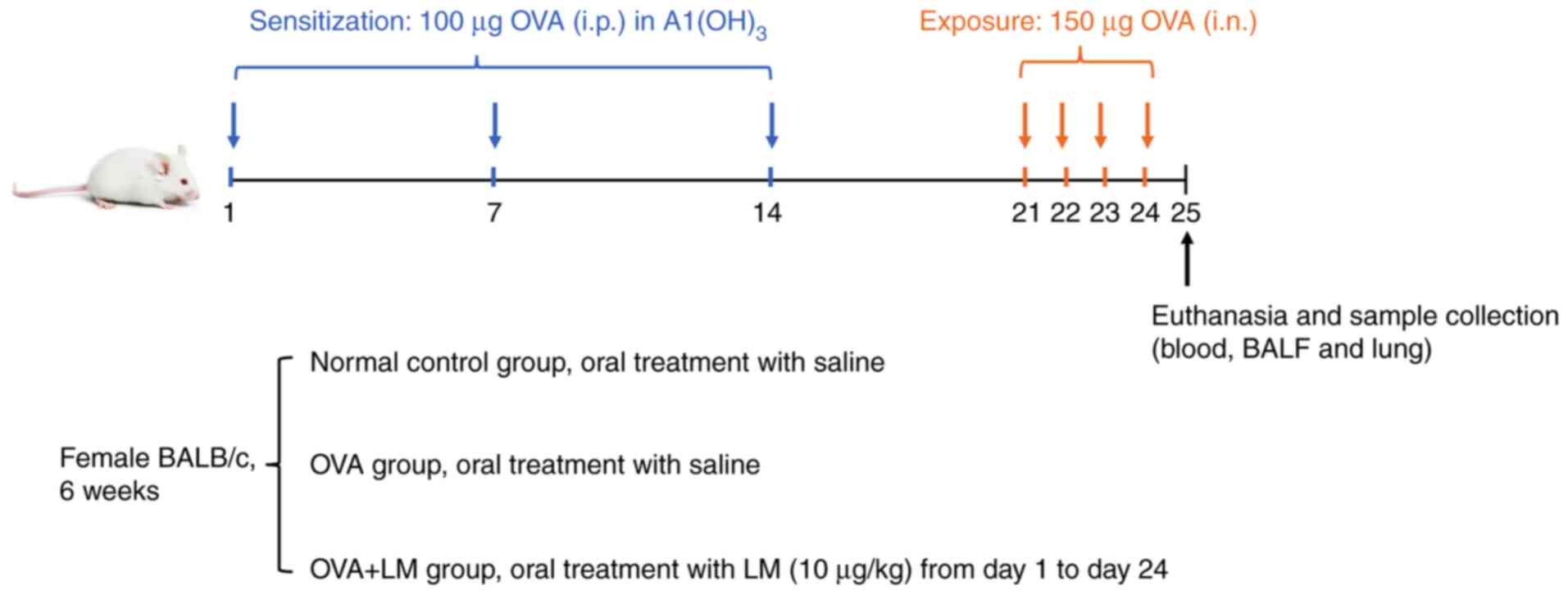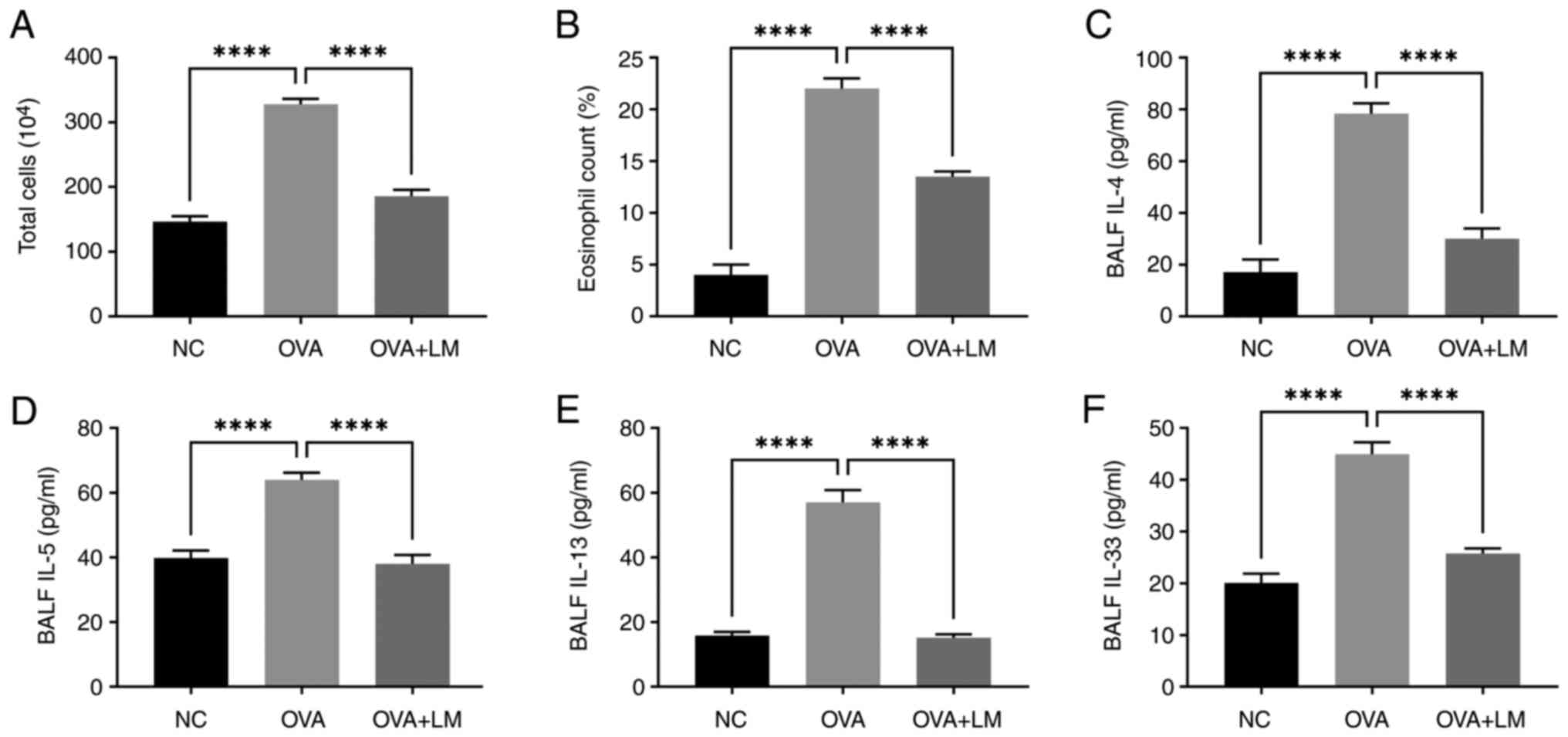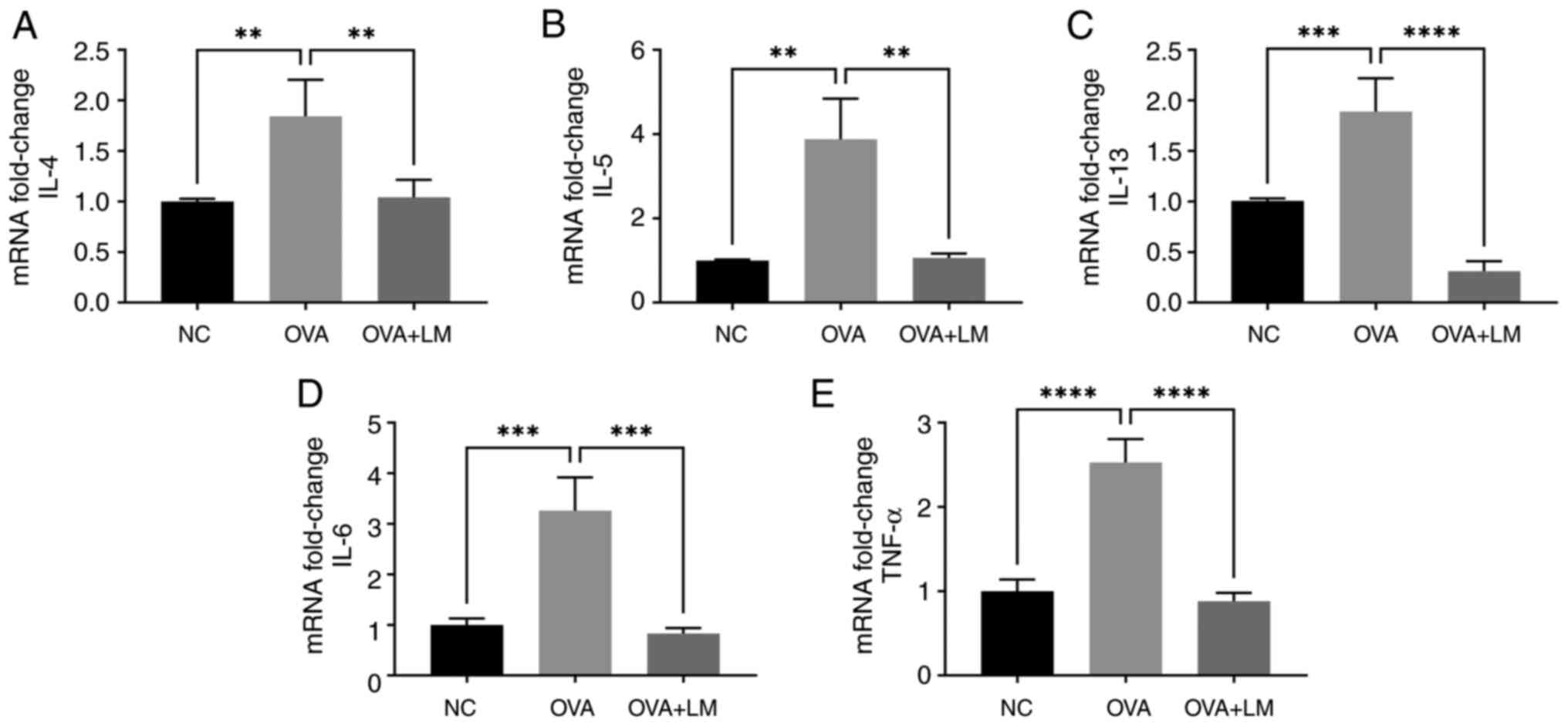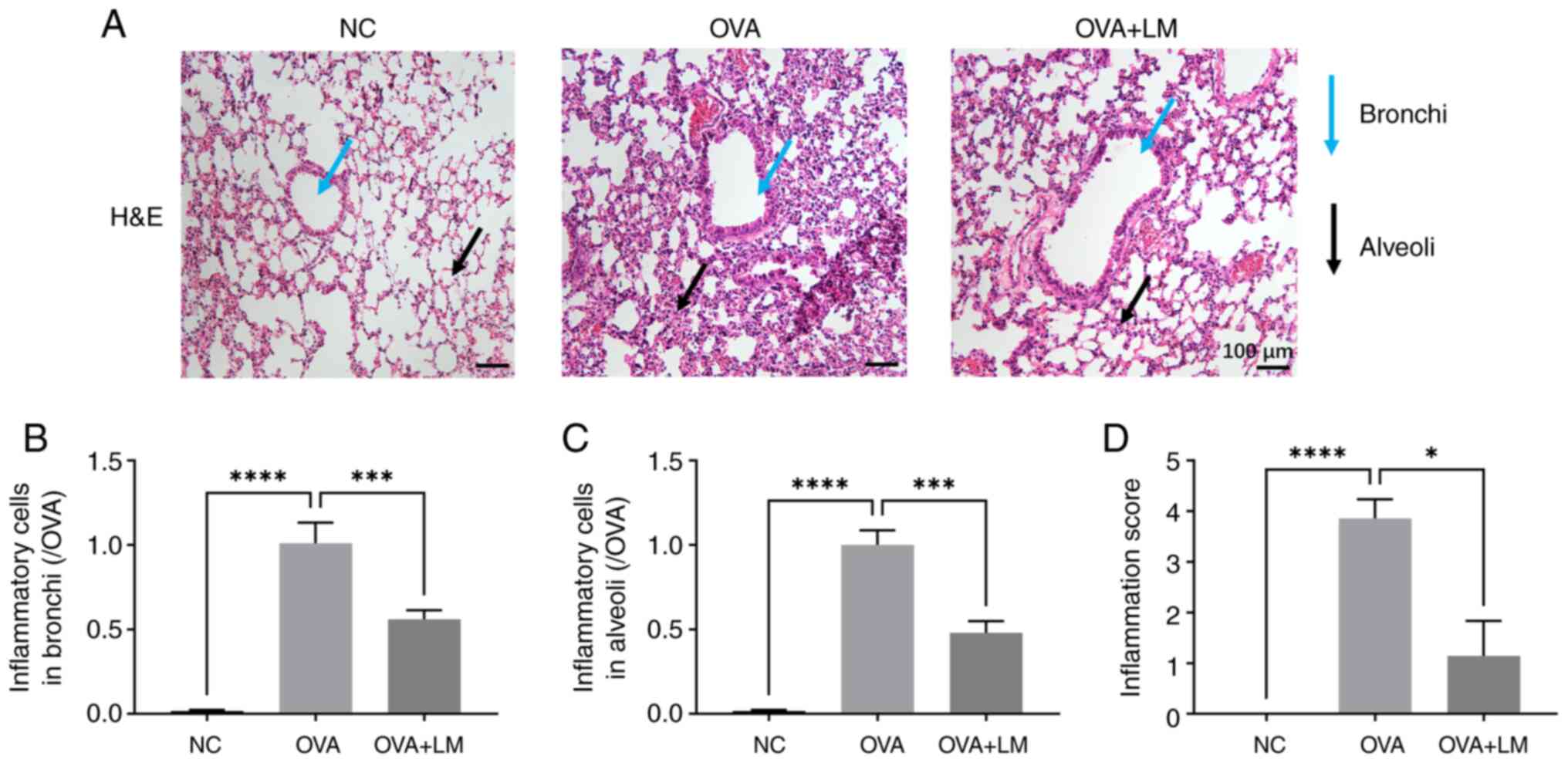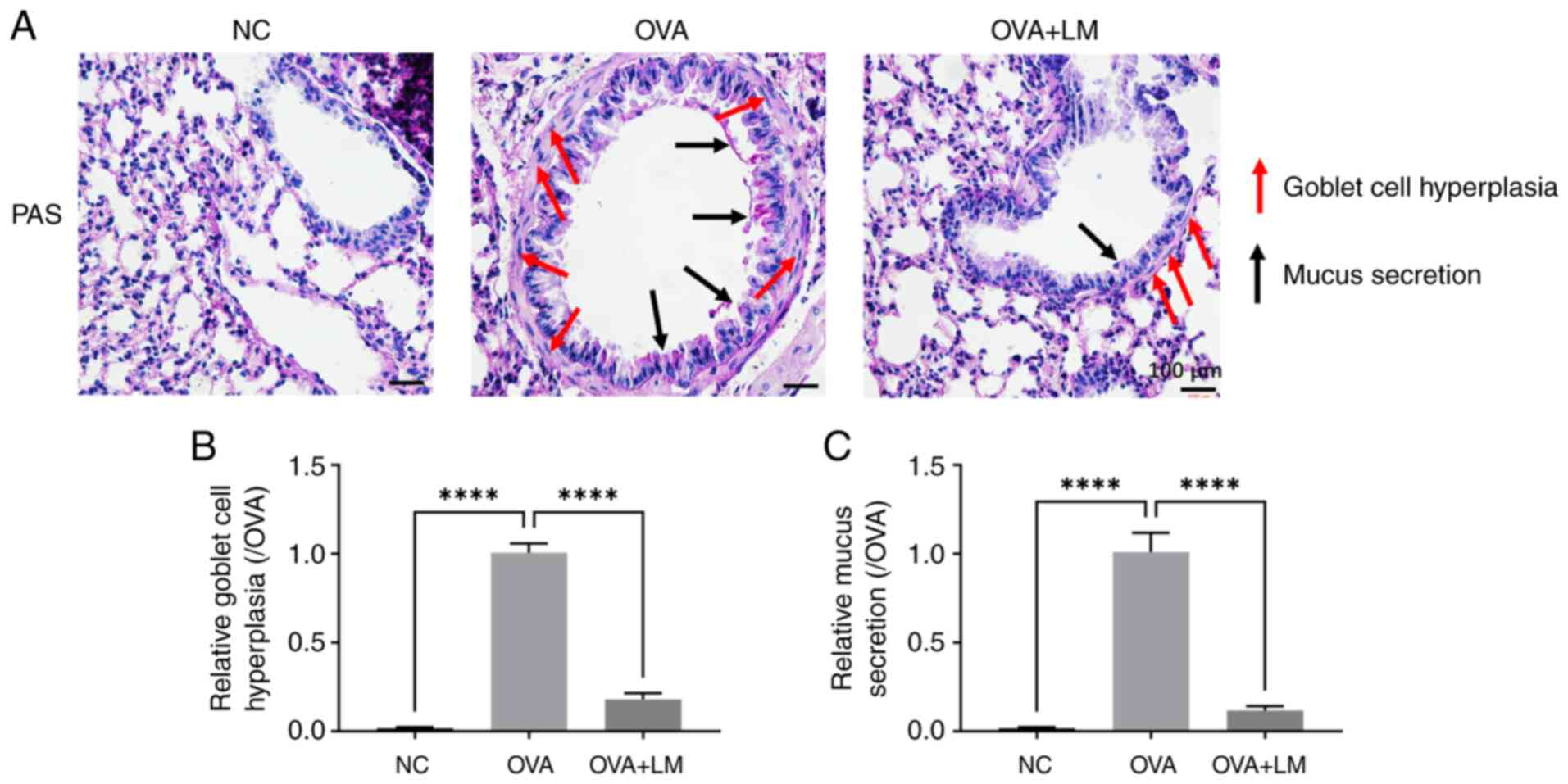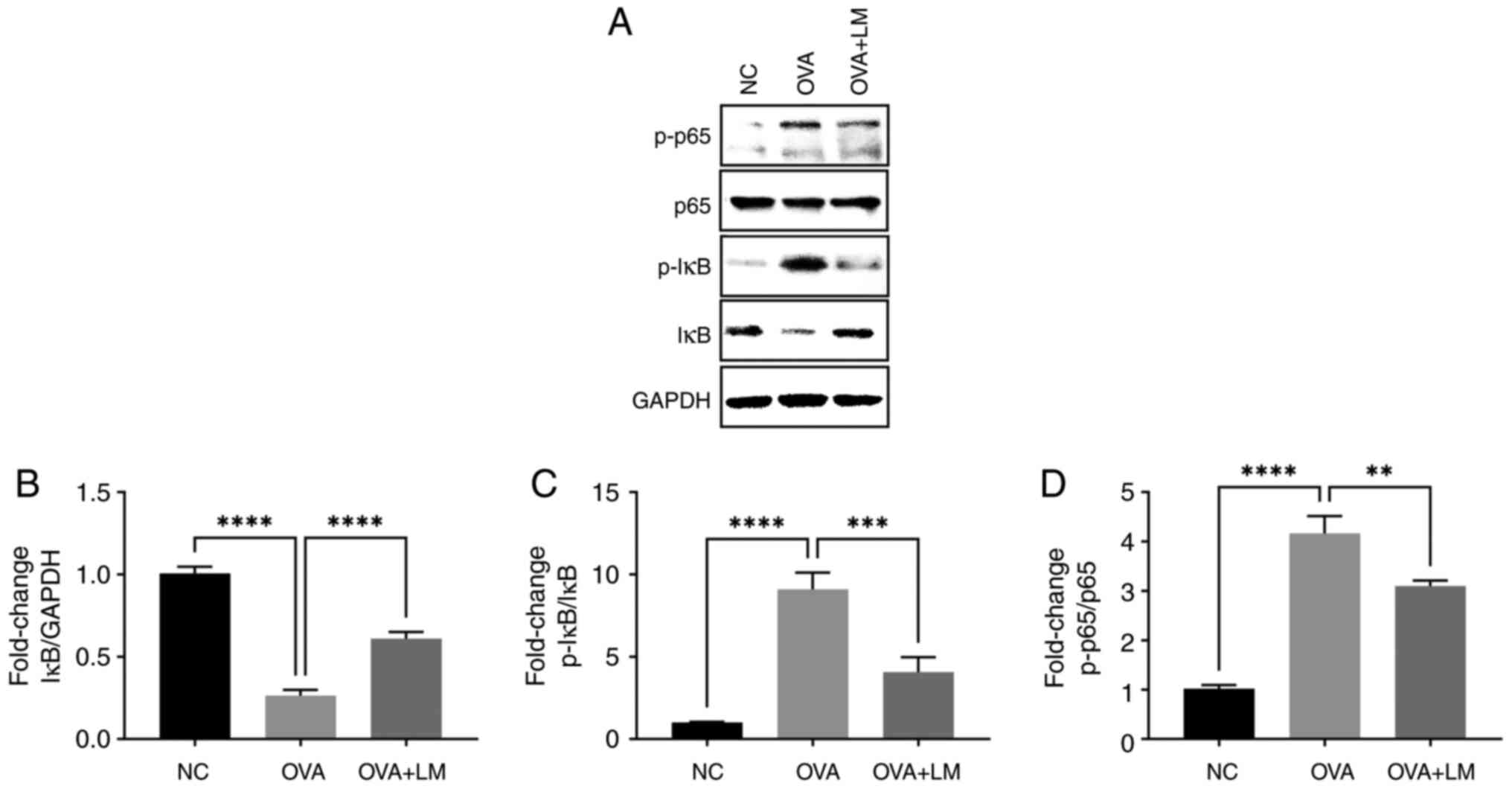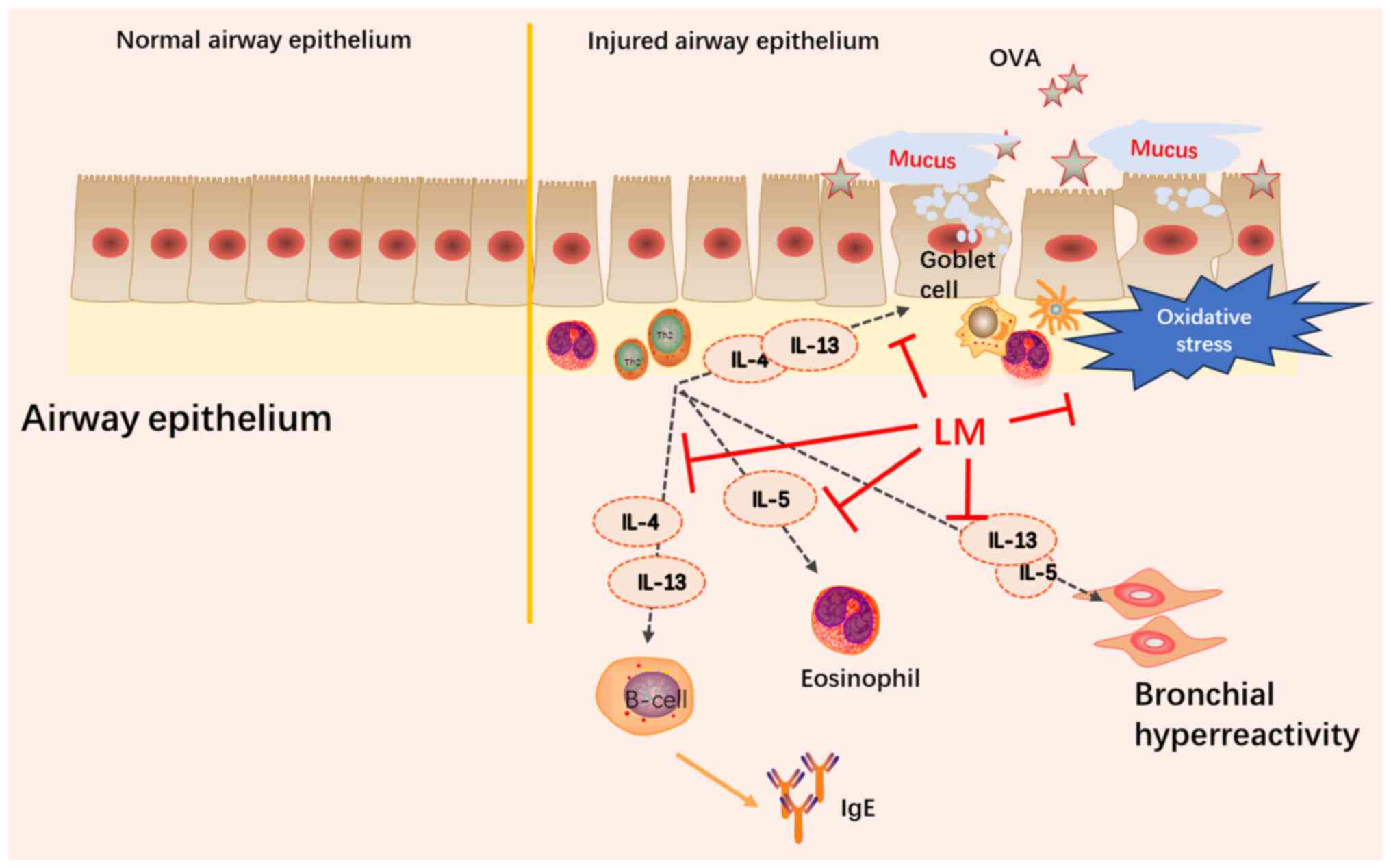Lipid mediators obtained from docosahexaenoic acid by soybean lipoxygenase alleviate ovalbumin‑induced allergic asthma in mice by reducing airway inflammation and oxidative stress
- Authors:
- Published online on: February 3, 2025 https://doi.org/10.3892/mmr.2025.13451
- Article Number: 86
-
Copyright: © Su et al. This is an open access article distributed under the terms of Creative Commons Attribution License.
Abstract
Introduction
Allergic asthma, the most common type of asthma, is an airway inflammatory disease driven by the many kinds of inflammatory cells (1,2). The primary characteristic of allergic asthma is the narrowing of airway due to the infiltration of immune cells, particularly eosinophils, leading to a range of phenomena, including enhanced mucus production and airway wall remodeling (3–5). Allergic asthma is characterized by a Th2 cell response, aberrant accumulation of Th2 cytokines [interleukin (IL)-4, IL-5, IL-9, and IL-13], and Th2-oriented cytokines (IL-6 and IL-33), which contribute to goblet cell dysplasia and accumulation of mucus (6,7). Therefore, targeting Th2 cytokines is a potential therapeutic approaches for severe asthma (8–11).
The activation of inflammatory cells in allergic asthma subsequently leads to the generation of a substantial amount of reactive oxygen species (ROS) (12). During the normal condition, the antioxidant and oxidant systems maintain balance; however, with the excessive accumulation of ROS, the balance was damaged, resulting in oxidative stress. Various cellular antioxidants can mitigate oxidative stress, such as superoxide dismutase (SOD), catalase, and glutathione (GSH) (13,14). Furthermore, the activation of nuclear factor-kappaB (NF-κB) pathway promotes the production of pro-inflammatory cytokines and recruits eosinophils, that play crucial roles in allergic inflammation and oxidative stress (15–17).
Previous studies suggested that dietary supplementation of omega-3 fatty acids, enriched with docosahexaenoic acid (DHA) and eicosapentaenoic acid (EPA), exerts beneficial effects in inflammatory diseases, including asthma (18–20). Notably, it has been observed that intake of omega-3 fatty acids can elevate the levels of specialized pro-resolving mediators (SPMs), potentially serving as the primary mechanism by which omega-3 fatty acids reduce inflammation (21,22). SPMs act as potent regulators of cytokines and chemokines production, thereby facilitating a return to tissue homeostasis (23,24). Additionally, studies have demonstrated that SPMs exhibit both anti-inflammatory and pro-resolution properties at more than thousands times lower doses compared to omega-3 fatty acids (25–27). Thus, SPMs are promising methods for asthma. Lipid mediators (LM;17S-monohydroxy docosahexaenoic acid, resolvin D5, and protectin DX at 3:47:50 ratio), produced from DHA by soybean lipoxygenase, attenuate atopic dermatitis, which is an allergic condition involving the inhibition of inflammatory cytokines and mediators (28). Thus, we hypothesized that LM could mediate allergic asthma and evaluated the underlying mechanism of LM on allergic asthma in OVA-challenged mice.
Materials and methods
Animals
Female BALB/c mice (6 weeks) were obtained from Orient Bio (Gyeonggi, Korea). The animals were housed at under controlled conditions of temperature (21–23°C), relative humidity (60–70%), and a 12-h light/dark cycle. This study was reviewed and approved by the Institutional Animal Care and Use Committee and Institutional Animal Ethics Committee of the Korea Research Institute of Bioscience and Biotechnology (Daejeon, Korea) (KRIBB-AEC-23236).
Animal model and treatment
Ovalbumin (OVA), the chief globular egg white protein, has been widely used for allergic models (29,30). The mice were divided into three groups and the allergic asthma model was induced by OVA. As depicted in Fig. 1, sensitization of the mice occurred through intraperitoneal (i.p.) administration of 100 µg of OVA (Sigma-Aldrich, St. Louis, MO) on days 1, 7, and 14. Subsequently, 150 µg of OVA was intranasally (i.n.) administered to the mice from days 21 to 24. In the normal control group (NC) and OVA alone group, saline was orally administered; however, in the OVA + LM group, LM (10 µg/kg) was orally treated. The mice were sacrificed for blood, bronchoalveolar lavage fluid (BALF), and lung tissue collection on Day 25. The dosage selection for LM was based on a previous study (28,31). The mice were euthanized via 5% isoflurane in oxygen until breathing ceases.
Collection of BALF
The BALF was obtained by lavaging the lungs with phosphate-buffered saline (PBS), ensuring a slow rinse to protect the epithelial cells in the bronchioalveolar space. Subsequently, centrifugation for 10 min was performed to separate the supernatants for cytokines analysis and resuspend the cell pellets for cell counting (32).
Measurement of cytokines and IgE level
IL-4, IL-5, IL-13, and IL-33 levels in BALF and IL-6, TNF-α, and IgE levels in serum were measured using ELISA kits (Abcam, Cambridge, MA) based on the manufacturer's protocols.
Histological analysis
After dissecting the lungs, tissue sections were fixed in 4% paraformaldehyde. Subsequently, they underwent dehydration using ethanol and xylene. The dehydrated tissue was then embedded in paraffin and stained with H&E (Sigma) to evaluate the infiltration of inflammatory cells. The inflammatory score was determined by assigning grades: 0, no inflammation; 1, minimal inflammation; 2, mild inflammation; 3, moderate inflammation; and 4, severe inflammation (11). Additionally, the slides were subjected to periodic acid Schiff (PAS; Abcam) staining for assessing mucus production.
Oxidative stress assays in lung tissue
The level of malondialdehyde (MDA) was quantified by lipid peroxidation colorimetric/fluorometric assay kit (ab118970), GSH was determined by GSH assay colorimetric kit (ab239727), and the activity of SOD was analyzed by superoxide dismutase activity assay kit (ab65354) based on the protocols accompanying the kits from Abcam.
Western blot analysis
The protein was isolated from homogenized lung tissue via radio immunoprecipitation assay buffer with protein inhibitors. Subsequently, the proteins were separated by sodium dodecyl sulfate-polyacrylamide gel and transferred onto polyvinylidene fluoride membranes, followed by incubation with blocking buffer and incubation of primary antibodies against p-p65 (1:1,000, ab76302, Abcam), p65 (1:1,000, ab16502, Abcam), IkB (1:2,000, ab32518, Abcam), and p-IkB (1:1,000. ab133462, Abcam). Finally, horseradish peroxidase-conjugated goat anti-rabbit antibodies (1:20,000, ab205718, Abcam) were applied to the membranes for a period of 2 h. The relative levels of protein were calculated using ImageJ software (1.48v; National Institutes of Health).
Reverse transcription-quantitative PCR (RT-qPCR)
The lung tissue was subjected to RNA isolation using a MiniBEST kit (TaKaRa, Tokyo, Japan). Briefly, transcript levels were quantified using a One-Step AccuPower GreenStar RT-qPCR PreMix kit (Bioneer Corporation, Daejeon, Korea). RT-qPCR analysis was performed on the CFX Connect system (Bio-Rad, CA, USA). The relative mRNA expression of target genes was determined using the 2−ΔΔCq method. Gene-specific primers utilized in this study are listed in Table I (33).
Statistical analysis
Data were shown as means ± standard deviations (SDs). Statistical analysis was conducted using GraphPad Prism 9.0 software (GraphPad, San Diego, CA, USA). The Shapiro-Wilk test was used to test for normality. Comparisons were analyzed by ANOVA, followed by Dunnett's test as the post hoc test; or by Kruskal-Wallis test followed by Dunn's test as the post hoc test. Statistical significance was defined as P<0.05.
Results
LM reduces the level of inflammatory cells in the BALF in OVA-induced asthma
As shown in Fig. 2A and B, OVA-challenged mice exhibited a higher level in both total cell number (P<0.0001) and eosinophil percentage (P<0.0001) compared to the normal condition. However, treatment with LM effectively attenuated the accumulation of OVA-induced eosinophils (P<0.0001 vs. OVA group). These findings suggest that LM possesses the ability to suppress the infiltration of inflammatory cells, particularly eosinophils, in lung tissue following OVA exposure.
LM decreases Th2 cytokines in BALF
OVA challenge resulted in elevated levels of IL-4 (78.21±4.10 pg/ml, P<0.0001 vs. NC group), IL-5 (64.09±2.21 pg/ml, P<0.0001 vs. NC group), and IL-13 (57.02±3.96 pg/ml, P<0.0001 vs. NC group) in BALF; however, treatment with LM markedly reduced the expression of these cytokines, as evidenced by a reduction in IL-4 level to 30.24±3.76 pg/ml (P<0.0001 vs. OVA group), IL-5 to 37.99±2.78 pg/ml (P<0.0001 vs. OVA group), and IL-13 to 15.16±1.10 pg/ml (P<0.0001 vs. OVA group) (Fig. 2C-E). Lung epithelial cells produce IL-33, a type of Th2-oriented cytokine that promotes IL-5 production (34). The IL-33 level was markedly enhanced almost 2 times in OVA mice (45.83±2.69 pg/ml, P<0.0001) compared to the normal control group. However, LM treatment recovered IL-33 to 26.00±1.41 pg/ml (P<0.0001 vs. OVA group), close to the normal level (Fig. 2F).
LM inhibits pro-inflammatory cytokines and IgE level in the serum
The levels of IL-6 and TNF-α, which are representative inflammatory cytokines, were significantly elevated in the serum of asthmatic animals (167.12±6.25 pg/ml, P<0.0001; 109.17±7.17 pg/ml, P<0.0001, respectively) compared to normal controls (58.97±6.35 pg/ml; 30.50±3.81 pg/ml, respectively). However, treatment with LM effectively suppressed the expression of both cytokines induced by OVA allergen (99.45±6.12 pg/ml, P<0.001, vs. OVA group; 62.51±4.03 pg/ml, P<0.001 vs. OVA group) (Fig. 3A and B). The OVA-induced asthma group exhibited a significant increase in IgE level, reaching to 90.24±5.98 ng/ml (P<0.0001 vs. NC group), which was nearly three times of the control group. However, treatment with LM resulted in a substantial reduction in IgE level to 56.50±2.70 ng/ml (P<0.001 vs. OVA group) (Fig. 3C).
LM inhibits the expression of inflammatory cytokine in OVA-induced asthma
The expression levels of IL-4, IL-5, and IL-13 were upregulated in lung tissues following OVA challenge compared to the normal control group (P<0.01, P<0.01, P<0.001, respectively). However, treatment with LM effectively suppressed these cytokines at the gene level in allergic asthma (P<0.01, P<0.01, P<0.0001 vs. OVA group, respectively) (Fig. 4A-C). Additionally, LM treatment resulted in downregulation of IL-6 and TNF-α expressions compared to OVA-induced asthma (P<0.001, P<0.0001, respectively) (Fig. 4D and E).
LM modulates antioxidant markers in OVA-induced asthma
To investigate the role of LM in oxidative stress, we quantified key antioxidant biochemical markers in lung tissue, including MDA, SOD, and GSH (35,36). In OVA-induced mice, MDA level was significantly increased to 9.14±0.62 nmol/g (P<0.0001 vs. NC group) (Fig. 5A), while the crucial antioxidants SOD and GSH were significantly reduced to 1.34±0.11 U/mg protein (P<0.0001 vs. NC group) and 6.52±0.66 µmol/g (P<0.0001 vs. NC group) in lung tissue (Fig. 5B and C). Notably, administration of LM effectively restored these mediators to near-normal levels, with MDA decreasing to 5.55±0.53 nmol/g (P<0.001 vs. OVA group), SOD increasing to 2.48±0.17 U/mg protein (P<0.001 vs. OVA group), and GSH enhancing to 11.42±0.52 µmol/g (P<0.001 vs. OVA group). Overall, LM exhibited the ability to modulate oxidative stress in an OVA-induced asthma model.
LM ameliorates the histopathological changes in OVA-induced asthma
As depicted in Fig. 6, OVA stimulation resulted in inflammatory cell infiltration in both bronchi and alveoli of lung tissues (P<0.0001 vs. NC group); however, treatment with LM significantly modulated the inflammatory cell profile within the lung (P<0.001 vs. OVA group) (Fig. 6A-C). Furthermore, the inflammatory score was markedly elevated in the OVA group (P<0.0001 vs. NC group), which was then attenuated by LM (P<0.05 vs. OVA group) (Fig. 6D). Goblet cell hyperplasia and mucus excessive production are commonly employed to assess the airway remodeling (37). As shown in Fig. 7, OVA stimulation induced goblet cell dysplasia in the asthma group (P<0.0001 vs. NC group), which was mitigated by LM treatment (P<0.0001 vs. OVA group). Furthermore, LM treatment suppressed OVA-induced mucus secretion in the bronchi (P<0.0001 vs. OVA group). These findings suggest that LM modulated the histopathological alterations associated with OVA-induced asthma.
LM suppresses NF-κB signaling pathway during OVA-induced asthma
In this study, we postulated that LM could effectively inhibit NF-κB signaling in OVA-induced asthma. As shown in Fig. 8, OVA challenge upregulated the phosphorylated IκB and NF-κB (p65) expression, and increased the degradation of IκB (P<0.0001 vs. NC group, respectively). However, treatment with LM significantly suppressed NF-κB activation as evidenced by inhibition of IκB degradation (P<0.0001 vs. OVA group), and downregulated levels of p-IκB (P<0.001 vs. OVA group) and p-p65 (P<0.01 vs. OVA group). These findings demonstrate the anti-inflammatory potential of LM through inhibition of the NF-κB pathway in OVA-sensitized mice.
Discussion
The main features of allergic asthma include inflammation, excessive mucus production, and remodeling in the airway (32). Despite the availability of a few drugs, it is imperative to explore more effective approaches for treating asthma. Over the years, there have been numerous conflicting reports regarding the supplementation of omega-3 fatty acids in asthma management. Several studies have demonstrated that intake of omega-3 fatty acids exerts a protective effect in asthma (38–42). However, other findings suggest that omega-3 fatty acid supplementation may either exacerbate pulmonary inflammation or exhibit no significant reduction in its severity, rendering it ineffective in human trials (43,44). Conversely, SPMs, derived from DHA or EPA, are demonstrated robust and favorable effects on inflammatory diseases even at doses thousands of times lower than DHA or EPA, including asthma (45–47). Revealing the involvement of SPMs in inflammatory responses associated with asthma enhances the comprehension of dysfunctional inflammation resolution mechanisms and unveils potential therapeutic targets for managing this condition. In this study, OVA exposure successfully induced asthmatic features in mice including elevated eosinophils in BALF and lung pro-inflammatory symptoms along with goblet cell hyperplasia, increased mucus production, and oxidative stress. Furthermore, treatment with LM significantly reduced inflammatory cell infiltration into the airway and lung while attenuating airway remodeling and modulating oxidative stress levels. These findings demonstrate the efficacy of LM in regulating inflammation in asthma (Fig. 9).
Eosinophils play a pivotal role in allergic inflammation and the development of airway remodeling during Th2-type allergic asthma (4). Th2 cytokines, such as IL-4, IL-5, and IL-13, promote the infiltration of eosinophils into lung tissue (48). IL-5 facilitates the eosinophils to migrate into the lungs (6). IL-4 and IL-13 stimulate B cells to secrete IgE, which subsequently activates mast cells and basophils in allergic diseases (49). Additionally, IL-13 influences smooth muscle activity and airway mucus secretion (50,51). Therefore, these cytokines represent important targets for suppressing asthma. In this study, we observed excessive production of these Th2-related cytokines following OVA induction in mice, suggesting an allergic-like asthma model. Resolvin D1 and resolvin E1 markedly decreased airway eosinophilia and mucus metaplasia, accompanied with decreased Th2 cytokines in mice asthma model (25–27). Similarly, treatment with LM significantly reduced levels of Th2-related cytokines, while concurrently decreasing eosinophil counts in BALF and lung tissues. Goblet cell hyperplasia is a pathophysiological characteristic of asthma, significantly augmenting mucus production, thereby leading to airway obstruction (52,53). As anticipated, OVA induced goblet cell hyperplasia and resulted in excessive mucus accumulation; however, oral treatment with LM substantially mitigated goblet cell dysplasia and suppressed mucus secretion, indicating the inhibitory role of LM in asthmatic airway remodeling.
IgE is induced by Th2 cytokines and contributes to the asthma (10,48). In present study, OVA challenge led to an elevated level of IgE in the serum, while LM effectively attenuated the OVA-induced increase in serum IgE. IL-6 and TNF-α are widely recognized as key markers of inflammation (34). TNF-α has recently emerged as a crucial factor in refractory asthma and plays multiple roles in airway pathology during asthmatic conditions (54). Additionally, IL-6 promotes Th2 differentiation and IL-4 production (55). Our findings demonstrate that stimulation with OVA resulted in upregulated expression of both IL-6 and TNF-α in lung tissue and serum, which were significantly suppressed by LM treatment. These results highlight the anti-inflammatory effects of LM on asthma.
Oxidative stress is crucial in the pathogenesis of asthma, as it may contribute to the airway inflammation via airway hyper-responsiveness, mucus secretion, and pro-inflammatory cytokines (56,57). In our study, we observed elevated level of MDA along with decreased SOD activity and GSH level during OVA-induced asthma, indicating oxidative stress in OVA-induced asthma model. Importantly, LM highly mediated these anti-oxidative parameters which were associated with the protective role exerted by LM in mitigating asthma pathology.
NF-κB is a pivotal mediator in the progression of asthma (58). IκB, which inhibits NF-κB, is bound to NF-κB in the cytoplasm. Within the inducer, IκB was phosphorylated and degraded, resulting in the activation of NF-κB (59). Activation of NF-κB leads to the expression of inflammatory cytokines and chemokines, contributing to the Th2 cell differentiation in allergic asthma (60). In our previous investigations, we found LM attenuated NF-κB signaling pathway in RAW264.7 cells and atopic dermatitis (28,31). In the present study, OVA exposure increased the expression of p-IκB and p-p65, leading to the activation of the NF-κB signaling pathway. Treatment with LM drastically inhibited the degradation and phosphorylation of IκB. Furthermore, LM inhibited the expression of p-p65. Taken together, the results suggest that LM ameliorates OVA-induced allergic asthma by regulating the NF-κB activation.
In conclusion, this study demonstrates that LM shows promise as a viable option for both alternative and adjunctive therapy in the management of asthma. Firstly, LM is endogenous to the human body, ensuring its safety; Secondly, LM exhibits significant improvements at significantly lower doses compared to omega-3 fatty acids, facilitating ease of intake. However, more research is required to explore optimal therapeutic strategies including dose-dependency, administration methods, and clinical testing.
Acknowledgements
Not applicable.
Funding
The present study was supported by the Microbial Biotechnology Research Center, Korea Research Institute of Bioscience and Biotechnology from the Ministry of Science and ICT (grant no. KGM5482423) and the National Research Foundation of Korea grant funded by the Korean government (grant no. NRF2021R1A2C2013498).
Availability of data and materials
The data generated in the present study may be requested from the corresponding author.
Authors' contributions
YS conceptualized and designed the study, performed experiments, analyzed data, and wrote and revised manuscript. HSC analyzed data, contributed to critical revisions and contributed to the final manuscript. SKK and YH performed experiments and analyzed data. SCC and JHS investigated the literature, supplied the materials and analyzed data. YSJ contributed to data analysis and critical revisions of the intellectual content. JHC contributed to data analysis, and the draft and final manuscript. JWS conceptualized the study, and contributed to the draft and final manuscript. YS and JWS confirmed the authenticity of all the raw data. All authors have read and approved the final manuscript.
Ethics approval and consent to participate
The present study was reviewed and approved by the Institutional Animal Care and Use Committee and Institutional Animal Ethics Committee of the Korea Research Institute of Bioscience and Biotechnology (Daejeon, South Korea; approval no. KRIBB-AEC-23236).
Patient consent for publication
Not applicable.
Competing interests
The authors declare that they have no competing interests.
References
|
Pawankar R: Allergic diseases and asthma: A global public health concern and a call to action. World Allergy Organ J. 7:122014. View Article : Google Scholar : PubMed/NCBI | |
|
Agache I, Eguiluz-Gracia I, Cojanu C, Laculiceanu A, Del Giacco S, Zemelka-Wiacek M, Kosowska A, Akdis CA and Jutel M: Advances and highlights in asthma in 2021. Allergy. 76:3390–3407. 2021. View Article : Google Scholar : PubMed/NCBI | |
|
Lambrecht BN and Hammad H: The immunology of asthma. Nat Immunol. 16:45–56. 2015. View Article : Google Scholar : PubMed/NCBI | |
|
Possa SS, Leick EA, Prado CM, Martins MA and Tibério IFLC: Eosinophilic inflammation in allergic asthma. Front Pharmacol. 4:462013. View Article : Google Scholar : PubMed/NCBI | |
|
Hammad H and Lambrecht BN: The basic immunology of asthma. Cell. 184:1469–1485. 2021. View Article : Google Scholar : PubMed/NCBI | |
|
Stokes JR and Casale TB: Characterization of asthma endotypes: Implications for therapy. Ann Allergy Asthma Immunol. 117:121–125. 2016. View Article : Google Scholar : PubMed/NCBI | |
|
Abdelaziz MH, Abdelwahab SF, Wan J, Cai W, Huixuan W, Jianjun C, Kumar KD, Vasudevan A, Sadek A, Su Z, et al: Alternatively activated macrophages; a double-edged sword in allergic asthma. J Transl Med. 18:582020. View Article : Google Scholar : PubMed/NCBI | |
|
Ma Y, Ge A, Zhu W, Liu YN, Ji NF, Zha WJ, Zhang JX, Zeng XN and Huang M: Morin attenuates ovalbumin-induced airway inflammation by modulating oxidative stress-responsive MAPK signaling. Oxid Med Cell Longev. 2016:58436722016. View Article : Google Scholar : PubMed/NCBI | |
|
Saeedavi M, Goudarzi M, Mehrzadi S, Basir Z, Hasanvand A and Hosseinzadeh A: Sinapic acid ameliorates airway inflammation in murine ovalbumin-induced allergic asthma by reducing Th2 cytokine production. Life Sci. 307:1208582022. View Article : Google Scholar : PubMed/NCBI | |
|
Ezz-Eldin YM, Aboseif AA and Khalaf MM: Potential anti-inflammatory and immunomodulatory effects of carvacrol against ovalbumin-induced asthma in rats. Life Sci. 242:1172222020. View Article : Google Scholar : PubMed/NCBI | |
|
Zafar MS, Shahid K, Gobe GC, Yasmin R, Naseem N and Shahzad M: Suppression of cytokine storm and associated inflammatory mediators by salicylaldehyde derivative of pregabalin: An innovative perspective for alleviating airway inflammation and lung remodeling. J King Saud Univ Sci. 34:1018772022. View Article : Google Scholar | |
|
Sahiner UM, Birben E, Erzurum S, Sackesen C and Kalayci O: Oxidative stress in asthma. World Allergy Organ J. 4:151–158. 2011. View Article : Google Scholar : PubMed/NCBI | |
|
Bowler RP and Crapo JD: Oxidative stress in airways: Is there a role for extracellular superoxide dismutase? Am J Respir Crit Care Med. 166:S38–S43. 2002. View Article : Google Scholar : PubMed/NCBI | |
|
Michaeloudes C, Abubakar-Waziri H, Lakhdar R, Raby K, Dixey P, Adcock IM, Mumby S, Bhavsar PK and Chung KF: Molecular mechanisms of oxidative stress in asthma. Mol Aspects Med. 85:1010262022. View Article : Google Scholar : PubMed/NCBI | |
|
Lee KS, Lee HK, Hayflick JS, Lee YC and Puri KD: Inhibition of phosphoinositide 3-kinase delta attenuates allergic airway inflammation and hyperresponsiveness in murine asthma model. FASEB J. 20:455–465. 2006. View Article : Google Scholar : PubMed/NCBI | |
|
Ganesh Yerra V, Negi G, Sharma SS and Kumar A: Potential therapeutic effects of the simultaneous targeting of the Nrf2 and NF-κB pathways in diabetic neuropathy. Redox Biol. 1:394–397. 2013. View Article : Google Scholar : PubMed/NCBI | |
|
El-Hashim AZ, Renno WM, Abduo HT, Jaffal SM, Akhtar S and Benter IF: Effect of inhibition of the ubiquitin-proteasome-system and IκB kinase on airway inflammation and hyperresponsiveness in a murine model of asthma. Int J Immunopathol Pharmacol. 24:33–42. 2011. View Article : Google Scholar : PubMed/NCBI | |
|
Li J, Xun P, Zamora D, Sood A, Liu K, Daviglus M, Iribarren C, Jacobs D Jr, Shikany JM and He K: Intakes of long-chain omega-3 (n-3) PUFAs and fish in relation to incidence of asthma among American young adults: The CARDIA study. Am J Clin Nutr. 97:173–178. 2013. View Article : Google Scholar : PubMed/NCBI | |
|
Wendell SG, Baffi C and Holguin F: Fatty acids, inflammation, and asthma. J Allergy Clin Immunol. 133:1255–1264. 2014. View Article : Google Scholar : PubMed/NCBI | |
|
Kitz R, Rose MA, Schubert R, Beermann C, Kaufmann A, Böhles HJ, Schulze J and Zielen S: Omega-3 polyunsaturated fatty acids and bronchial inflammation in grass pollen allergy after allergen challenge. Respir Med. 104:1793–1798. 2010. View Article : Google Scholar : PubMed/NCBI | |
|
Siddiquee A, Patel M, Rajalingam S, Narke D, Kurade M and Ponnoth DS: Effect of omega-3 fatty acid supplementation on resolvin (RvE1)-mediated suppression of inflammation in a mouse model of asthma. Immunopharmacol Immunotoxicol. 41:250–257. 2019. View Article : Google Scholar : PubMed/NCBI | |
|
Miyata J and Arita M: Role of omega-3 fatty acids and their metabolites in asthma and allergic diseases. Allergol Int. 64:27–34. 2015. View Article : Google Scholar : PubMed/NCBI | |
|
Duvall MG and Levy BD: DHA- and EPA-derived resolvins, protectins, and maresins in airway inflammation. Eur J Pharmacol. 785:144–155. 2016. View Article : Google Scholar : PubMed/NCBI | |
|
Koltsida O, Karamnov S, Pyrillou K, Vickery T, Chairakaki AD, Tamvakopoulos C, Sideras P, Serhan CN and Andreakos E: Toll-like receptor 7 stimulates production of specialized pro-resolving lipid mediators and promotes resolution of airway inflammation. EMBO Mol Med. 5:762–775. 2013. View Article : Google Scholar : PubMed/NCBI | |
|
Levy BD: Resolvin D1 and Resolvin E1 promote the resolution of allergic airway inflammation via shared and distinct molecular counter-regulatory pathways. Front Immunol. 3:3902012. View Article : Google Scholar : PubMed/NCBI | |
|
Rogerio AP, Haworth O, Croze R, Oh SF, Uddin M, Carlo T, Pfeffer MA, Priluck R, Serhan CN and Levy BD: Resolvin D1 and aspirin-triggered resolvin D1 promote resolution of allergic airways responses. J Immunol. 189:1983–1991. 2012. View Article : Google Scholar : PubMed/NCBI | |
|
Aoki H, Hisada T, Ishizuka T, Utsugi M, Kawata T, Shimizu Y, Okajima F, Dobashi K and Mori M: Resolvin E1 dampens airway inflammation and hyperresponsiveness in a murine model of asthma. Biochem Biophys Res Commun. 367:509–515. 2008. View Article : Google Scholar : PubMed/NCBI | |
|
Su Y, Han Y, Choi HS, Lee GY, Cho HW, Choi H, Jang YS, Choi JH and Seo JW: Lipid mediators derived from DHA alleviate DNCB-induced atopic dermatitis and improve the gut microbiome in BALB/c mice. Int Immunopharmacol. 124:1109002023. View Article : Google Scholar : PubMed/NCBI | |
|
Zhou R, Shi X, Gao Y, Cai N, Jiang Z and Xu X: Anti-inflammatory activity of guluronate oligosaccharides obtained by oxidative degradation from alginate in lipopolysaccharide-activated murine macrophage RAW 264.7 cells. J Agric Food Chem. 63:160–168. 2015. View Article : Google Scholar : PubMed/NCBI | |
|
Sun N, Teng A, Zhao Y, Liu H, Tu J, Jia Q and Wang Q: Immunological and anticancer activities of seleno-ovalbumin (Se-OVA) on H22-bearing mice. Int J Biol Macromol. 163:657–665. 2020. View Article : Google Scholar : PubMed/NCBI | |
|
Su Y, Han Y, Choi HS, Lee GY, Cho HW, Choi H, Choi JH, Jang YS and Seo JW: Lipid mediators obtained from docosahexaenoic acid by soybean lipoxygenase attenuate RANKL-induced osteoclast differentiation and rheumatoid arthritis. Biomed Pharmacother. 171:1161532024. View Article : Google Scholar : PubMed/NCBI | |
|
Wu D, Li S, Liu X, Xu J, Jiang A, Zhang Y, Liu Z, Wang J, Zhou E, Wei Z, et al: Alpinetin prevents inflammatory responses in OVA-induced allergic asthma through modulating PI3K/AKT/NF-κB and HO-1 signaling pathways in mice. Int Immunopharmacol. 89:1070732020. View Article : Google Scholar : PubMed/NCBI | |
|
Livak KJ and Schmittgen TD: Analysis of relative gene expression data using real-time quantitative PCR and the 2(−Delta Delta C(T)) method. Methods. 25:402–408. 2001. View Article : Google Scholar : PubMed/NCBI | |
|
Lambrecht BN, Hammad H and Fahy JV: The cytokines of asthma. Immunity. 50:975–991. 2019. View Article : Google Scholar : PubMed/NCBI | |
|
Karadogan B, Beyaz S, Gelincik A, Buyukozturk S and Arda N: Evaluation of oxidative stress biomarkers and antioxidant parameters in allergic asthma patients with different level of asthma control. J Asthma. 59:663–672. 2022. View Article : Google Scholar : PubMed/NCBI | |
|
Cho YS and Moon H-B: The role of oxidative stress in the pathogenesis of asthma. Allergy Asthma Immunol Res. 2:183–187. 2010. View Article : Google Scholar : PubMed/NCBI | |
|
Huang WC, Fang LW and Liou CJ: Phloretin attenuates allergic airway inflammation and oxidative stress in asthmatic mice. Front Immunol. 8:1342017. View Article : Google Scholar : PubMed/NCBI | |
|
Schubert R, Kitz R, Beermann C, Rose MA, Lieb A, Sommerer PC, Moskovits J, Alberternst H, Böhles HJ, Schulze J and Zielen S: Effect of n-3 polyunsaturated fatty acids in asthma after low-dose allergen challenge. Int Arch Allergy Immunol. 148:321–329. 2009. View Article : Google Scholar : PubMed/NCBI | |
|
Mickleborough TD, Lindley MR, Ionescu AA and Fly AD: Protective effect of fish oil supplementation on exercise-induced bronchoconstriction in asthma. Chest. 129:39–49. 2006. View Article : Google Scholar : PubMed/NCBI | |
|
Yokoyama A, Hamazaki T, Ohshita A, Kohno N, Sakai K, Zhao GD, Katayama H and Hiwada K: Effect of aerosolized docosahexaenoic acid in a mouse model of atopic asthma. Int Arch Allergy Immunol. 123:327–332. 2000. View Article : Google Scholar : PubMed/NCBI | |
|
Morin C, Fortin S, Cantin AM and Rousseau É: MAG-EPA resolves lung inflammation in an allergic model of asthma. Clin Exp Allergy. 43:1071–1082. 2013. View Article : Google Scholar : PubMed/NCBI | |
|
Jiang T, Li P, Zhao J, Dai L, Sun D, Liu M, An L, Jia L, Jing X, Wang H, et al: Long-chain polyunsaturated fatty acids improve airway pathological features and gut microbial imbalances in BALB/c mice with ovalbumin-induced asthma. J Funct Foods. 81:1044652021. View Article : Google Scholar | |
|
Yin H, Liu W, Goleniewska K, Porter NA, Morrow JD and Peebles RS Jr: Dietary supplementation of omega-3 fatty acid-containing fish oil suppresses F2-isoprostanes but enhances inflammatory cytokine response in a mouse model of ovalbumin-induced allergic lung inflammation. Free Radic Biol Med. 47:622–628. 2009. View Article : Google Scholar : PubMed/NCBI | |
|
Schuster GU, Bratt JM, Jiang X, Pedersen TL, Grapov D, Adkins Y, Kelley DS, Newman JW, Kenyon NJ and Stephensen CB: Dietary long-chain omega-3 fatty acids do not diminish eosinophilic pulmonary inflammation in mice. Am J Respir Cell Mol Biol. 50:626–636. 2014. View Article : Google Scholar : PubMed/NCBI | |
|
Miyata J, Fukunaga K, Iwamoto R, Isobe Y, Niimi K, Takamiya R, Takihara T, Tomomatsu K, Suzuki Y, Oguma T, et al: Dysregulated synthesis of protectin D1 in eosinophils from patients with severe asthma. J Allergy Clin Immunol. 131:353–360.e2-e2. 2013. View Article : Google Scholar : PubMed/NCBI | |
|
Zambalde ÉP, Teixeira MM, Favarin DC, de Oliveira JR, Magalhães ML, Cunha MM, Silva WC Jr, Okuma CH, Rodrigues V Jr, Levy BD and Rogerio AP: The anti-inflammatory and pro-resolution effects of aspirin-triggered RvD1 (AT-RvD1) on peripheral blood mononuclear cells from patients with severe asthma. Int Immunopharmacol. 35:142–148. 2016. View Article : Google Scholar : PubMed/NCBI | |
|
Peh HY, Bruggemann TR, Ho WE, Cheng C, Tan WD, Wong WF and Levy BD: Resolvin D2 promotes the resolution of allergen-induced lung inflammation. J Immunol. 204 (1 Suppl):S147.192020. View Article : Google Scholar | |
|
Leigh R, Ellis R, Wattie JN, Hirota JA, Matthaei KI, Foster PS, O'Byrne PM and Inman MD: Type 2 cytokines in the pathogenesis of sustained airway dysfunction and airway remodeling in mice. Am J Respir Crit Care Med. 169:860–867. 2004. View Article : Google Scholar : PubMed/NCBI | |
|
Platts-Mills TAE, Schuyler AJ, Erwin EA, Commins SP and Woodfolk JA: IgE in the diagnosis and treatment of allergic disease. J Allergy Clin Immunol. 137:1662–1670. 2016. View Article : Google Scholar : PubMed/NCBI | |
|
Ingram JL and Kraft M: IL-13 in asthma and allergic disease: Asthma phenotypes and targeted therapies. J Allergy Clin Immunol. 130:829–844. 2012. View Article : Google Scholar : PubMed/NCBI | |
|
Alasandagutti ML, Ansari MSS, Sagurthi SR, Valluri V and Gaddam S: Role of IL-13 genetic variants in signalling of asthma. Inflammation. 40:566–577. 2017. View Article : Google Scholar : PubMed/NCBI | |
|
Curran DR and Cohn L: Advances in mucous cell metaplasia: A plug for mucus as a therapeutic focus in chronic airway disease. Am J Respir Cell Mol Biol. 42:268–275. 2010. View Article : Google Scholar : PubMed/NCBI | |
|
Lai H and Rogers DF: New pharmacotherapy for airway mucus hypersecretion in asthma and COPD: Targeting intracellular signaling pathways. J Aerosol Med Pulm Drug Deliv. 23:219–231. 2010. View Article : Google Scholar : PubMed/NCBI | |
|
Adner M, Rose AC, Zhang Y, Swärd K, Benson M, Uddman R, Shankley NP and Cardell LO: An assay to evaluate the long-term effects of inflammatory mediators on murine airway smooth muscle: Evidence that TNFalpha up-regulates 5-HT(2A)-mediated contraction contraction. Br J Pharmacol. 137:971–982. 2002. View Article : Google Scholar : PubMed/NCBI | |
|
Dienz O and Rincon M: The effects of IL-6 on CD4 T cell responses. Clin Immunol. 130:27–33. 2009. View Article : Google Scholar : PubMed/NCBI | |
|
Henderson WR Jr, Chi EY, Teo JL, Nguyen C and Kahn M: A small molecule inhibitor of redox-regulated NF-kappa B and activator protein-1 transcription blocks allergic airway inflammation in a mouse asthma model. J Immunol. 169:5294–5299. 2002. View Article : Google Scholar : PubMed/NCBI | |
|
Poynter ME: Airway epithelial regulation of allergic sensitization in asthma. Pulm Pharmacol Ther. 25:438–446. 2012. View Article : Google Scholar : PubMed/NCBI | |
|
Ma B, Athari SS, Mehrabi Nasab E and Zhao L: PI3K/AKT/mTOR and TLR4/MyD88/NF-κB signaling inhibitors attenuate pathological mechanisms of allergic asthma. Inflammation. 44:1895–1907. 2021. View Article : Google Scholar : PubMed/NCBI | |
|
Bao Z, Zhang P, Yao Y, Lu G, Tong Z, Yan B, Tu L, Yang G and Zhou J: Deguelin attenuates allergic airway inflammation via inhibition of NF-κb pathway in mice. Int J Biol Sci. 13:492–504. 2017. View Article : Google Scholar : PubMed/NCBI | |
|
Das J, Chen CH, Yang L, Cohn L, Ray P and Ray A: A critical role for NF-kappa B in GATA3 expression and TH2 differentiation in allergic airway inflammation. Nat Immunol. 2:45–50. 2001. View Article : Google Scholar : PubMed/NCBI |



